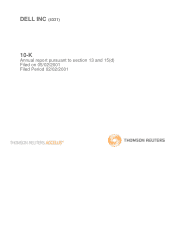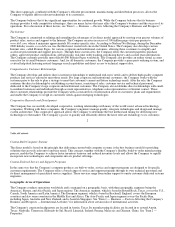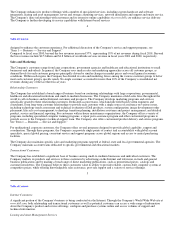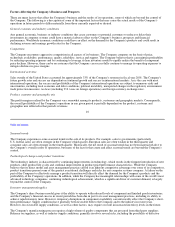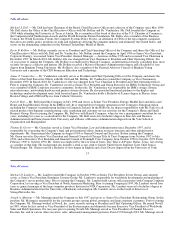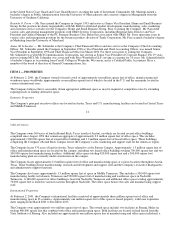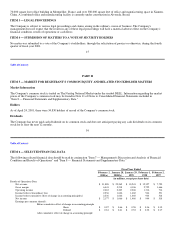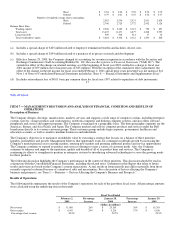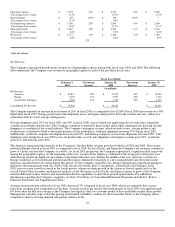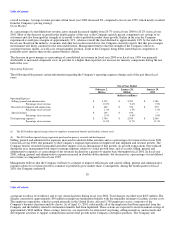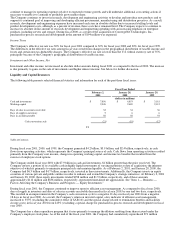Dell 2000 Annual Report Download - page 8
Download and view the complete annual report
Please find page 8 of the 2000 Dell annual report below. You can navigate through the pages in the report by either clicking on the pages listed below, or by using the keyword search tool below to find specific information within the annual report.
Consulting Services
Through Dell Technology Consulting, the Company offers professional consulting services to help customers select and implement
server and storage solutions. The Company provides consulting services in connection with systems management design and
implementation, E-commerce consulting, storage planning, storage consolidation, storage performance and tuning and backup and
recovery planning. The Company can also draw upon a network of established relationships with a variety of nationally recognized
specialty consulting firms.
Manufacturing
The Company operates manufacturing facilities in and around Austin, Texas; Eldorado do Sul, Brazil; Nashville, Tennessee;
Limerick, Ireland; Penang, Malaysia; and Xiamen, China. The Company's manufacturing process consists of assembly, functional
testing and quality control of the Company's computer systems. Testing and quality control processes are also applied to components,
parts and subassemblies obtained from suppliers. The Company's build-to-order manufacturing process is designed to allow the
Company to quickly produce customized computer systems and to achieve rapid inventory turnover and reduced inventory levels,
which lessens the Company's exposure to the risk of declining inventory values. This flexible manufacturing process also allows the
Company to incorporate new technologies or components into its product offerings quickly.
Quality control is maintained through the testing of components, parts and subassemblies at various stages in the manufacturing
process. Quality control also includes a burn-in period for completed
7
Table of Contents
units after assembly, on-going production reliability audits, failure tracking for early identification of production and component
problems and information from the Company's customers obtained through service and support programs. The Company conducts a
voluntary vendor certification program, under which qualified vendors commit to meet defined quality specifications. All of the
Company's manufacturing facilities have been certified as meeting ISO 9002 quality standards.
Product Development
The Company's product development efforts are focused on designing and developing competitively priced computer systems that
adhere to industry standards and incorporate the technologies and features that the Company believes are most desired by its
customers. To accomplish this objective, the Company must evaluate, obtain and incorporate new hardware, software, storage,
communications and peripherals technologies that are primarily developed by others. The Company's product development team
includes programmers, technical project managers and engineers experienced in system architecture, logic board design, sub-system
development, mechanical engineering, manufacturing processing and operating systems. This cross-functional approach to product
design has enabled the Company to develop systems with improved functionality, manufacturability, reliability, serviceability and
performance, while keeping costs competitive. The Company takes steps to ensure that new products are compatible with industry
standards and that they meet cost objectives based on competitive pricing targets.
The Company bases its product development efforts on cooperative, meaningful relationships with the world's most advanced
technology companies. These working partnerships allow the Company to use its direct model and build-to-order manufacturing
process to deliver, on a timely and cost-effective basis, those emerging technologies that are most relevant to its customers.
During fiscal year 2001, the Company incurred $482 million in research, development and engineering expenses, compared with
$374 million (excluding $194 million of acquired in-process research and development) for fiscal year 2000 and $272 million for
fiscal year 1999. The amount the Company spends on research, development and engineering activities, which the Company believes
to be important to its continued success and growth, is determined as part of the annual budget process and is based on cost-benefit
analyses and revenue forecasts. The Company prioritizes activities to focus on projects that it believes will have the greatest market
acceptance and achieve the highest return on the Company's investment.
Dell Ventures
Through Dell Ventures, the Company makes strategic investments in technology companies located in the United States and abroad.
These investments are designed to assist the Company in gaining greater access to leading-edge technologies and services, expanded
markets for the Company's products, insight into new markets and financial return. The Company generally invests in privately held
emerging technology companies with business objectives built around the Internet, services, server and storage products, and
communications. See "Item 1 — Business — Factors Affecting the Company's Business and Prospects — Equity Investments" for
information about certain risks associated with Dell Ventures. For additional information about risk on financial instruments, see
"Item 7 — Management's Discussion and Analysis of Financial Condition and Results of Operations — Market Risk."
Patents, Trademarks and Licenses
The Company holds a portfolio of 605 U.S. patents and 512 U.S. patent applications pending, and has a number of related foreign
patents and patent applications pending. The Company's U.S. patents expire in years 2005 through 2018. The inventions claimed in
those patents and patent applications cover aspects of the Company's current and possible future computer system products,
manufacturing processes and related technologies. The Company is developing a portfolio of

